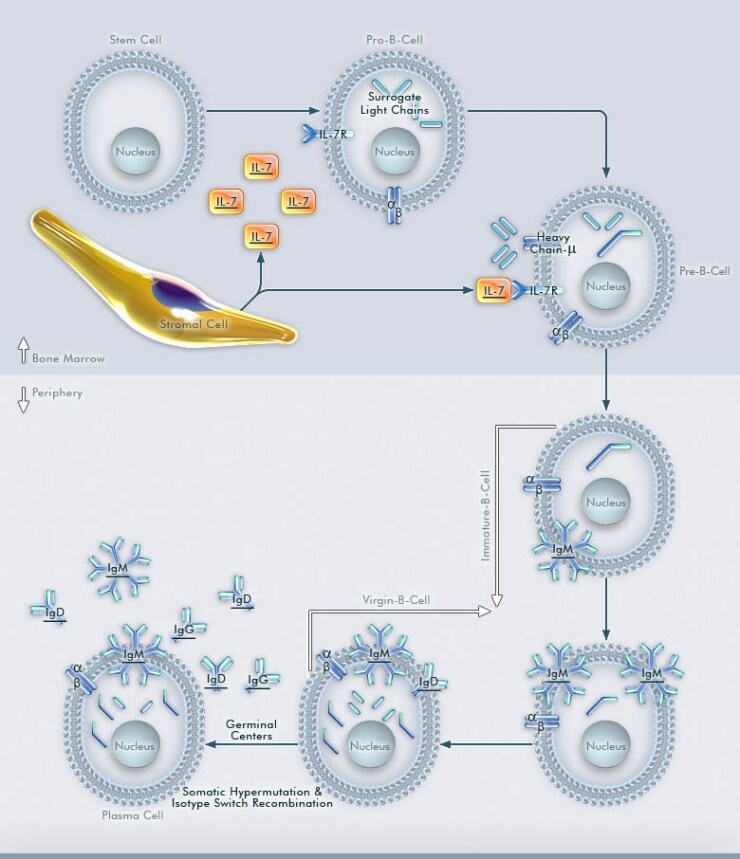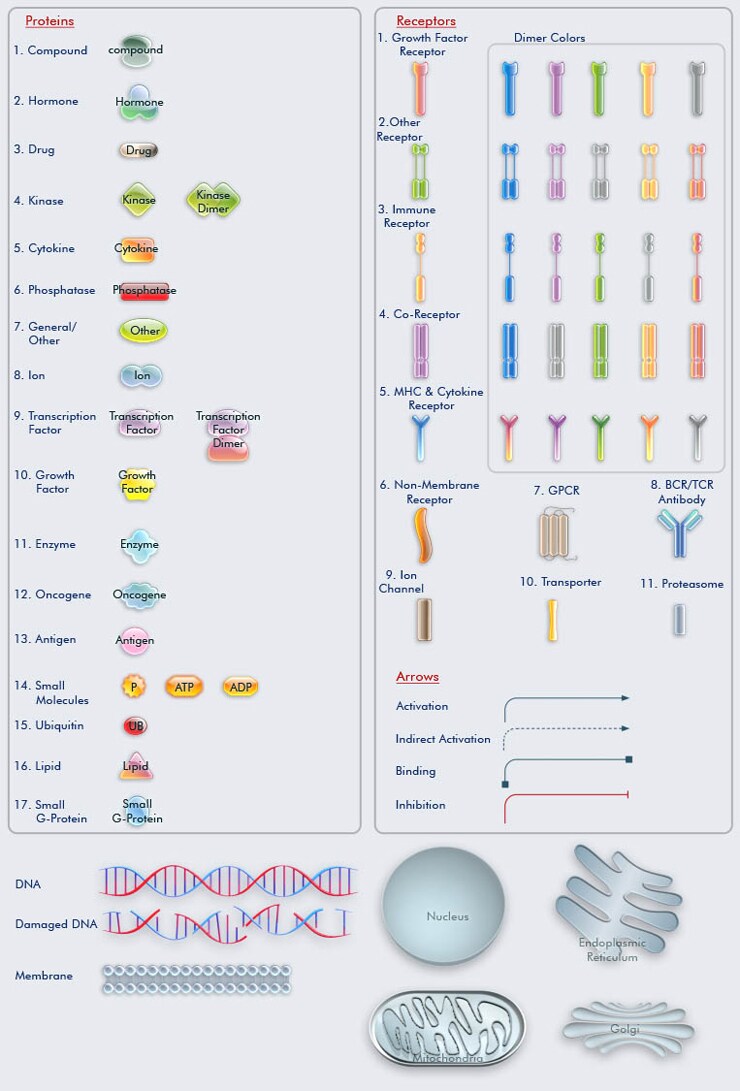Search
B-Cell Development Pathway
B lymphocytes are a population of white blood cells that express clonally diverse cell surface Ig (immunoglobulin) receptors, recognizing specific antigenic epitopes. The development of B-cells encompasses a continuum of stages that begin in primary lymphoid tissue (human fetal liver and fetal/adult marrow), with subsequent functional maturation in secondary lymphoid tissue (human lymph nodes and spleen). The functional end point is antibody production by terminally differentiated plasma
cells (Ref. 1).
B-cells express immunoglobulin (Ig) molecules on their outer surface and secrete them into the extracellular space. Secreted Ig are known as antibodies. Antibodies serve as effector molecules that neutralize microbes by binding to exposed antigens and targeting them to other components of the immune system, such as phagocytic cells and complement, that effect clearance. The genes that encode for antibodies are generated by many diversifying mechanisms including combinatorial rearrangement of gene segments, addition of non-templated (n) nucleotides at the junctions, and somatic hyper-mutation. Ig genes generate diversity in two stages: an antigen-independent and an antigen-dependent stage.
Antigen-independent diversity is generated in the bone marrow, where B-cells originate, by combinatorial rearrangement of gene segments and junctional diversity. Combinatorial diversity is created in a number of ways. First, each antibody molecule comprises one heavy- and one light-chain protein. Both the light- and heavy-chain genes are encoded by gene segments that are genetically rearranged during a process known as V(D)J recombination. Heavy chains are made up of three gene segments—variable (VH), diversity (DH) and joining (JH)—whereas light chains only have a V and J segment. In humans, there are ~50 known functional VH segments, 27 known functional DH segments, and six known functional JH segments. This arrangement allows for approximately 8100 combinations in the heavy chain alone. Humans also have two light-chain loci, kappa and lambda. Only one of these loci is expressed per cell so that each antibody either has a kappa light chain or a lambda light chain. Humans have 44 functional Vkappa, 5 Jkappa, 33 Vlambda genes and 5 Jlambda, resulting in 220 possible kappa chains and 165 possible lambda chains. Thus, this combinatorial rearrangement alone allows for greater than 3 million antibodies.
Junctional diversity is the result of multiple recombination site choices for each recombination event and the addition of non-templated nucleotides. Non-templated nucleotides are sometimes added at the junction by terminal deoxynucleotidyl transferase (TdT) between adjoining gene segments.
Antigen-dependent diversity is generated by somatic hyper-mutation in the periphery in a manner dependent on activation-induced cytidine deaminase (AID). During this process, mutations in the Ig genes are accumulated at a rate of up to 106 times the normal background rate. B-cells are subsequently selected for enhanced affinity for the eliciting antigen. It is estimated that these processes of diversification can generate ~1012 different antibodies, making it challenging to correctly identify the underlying germ line gene segments and subsequently the sequences of the complementarity-determining regions (CDRs) (Ref. 2).
B-cell development starts in bone marrow with the commitment of hematopoietic stem cells (HSCs) to the B-cell lineage and ends with formation of mature B-cells in peripheral secondary lymphoid organs (the spleen). It is the sequential expression and assembly of the components of the B-cell antigen receptor (BCR) that defines each developmental stage. The first developmental stage exhibiting commitment to the B-cell lineage is called pro-B and is characterized by rearrangement of the Ig heavy chain. In the pro-B stage, Iga (CD79a) and Igß (CD79b) are expressed at the cell surface in association with chaperon proteins such as calnexin. As soon as the heavy chain (µH) is successfully recombined, it is assembled with Iga and Igß and the surrogate light chains (SCLs) lambda5 and VpreB to form the pre-BCR like IgM (Ref. 3 & 4). Surface expression of this receptor marks the transition to the pre-B stage. Marrow stromal cell–derived interleukin-7 (IL-7) is a non-redundant cytokine for B-cell development that promotes V to DJ rearrangement and transmits survival/proliferation signals (Ref. 1). Unsuccessful recombination (with heavy chain VDJ fragments that are not in a proper reading frame) or unsuccessful pairing of the pre-BCR components results in pro-B-cells that are unable to proceed to the pre-B stage and leads to apoptosis. In the pre-B stage, the light chain V and J fragments are recombined, and, again, successful assembly of the mature form of the BCR marks the transition to the immature stage. In addition to their VDJ recombination status, all pro-B and pre-B stages can be recognized by their patterns of surface markers expression and their proliferative state. Because DNA replication during proliferation is associated with homologous recombination and VDJ rearrangement is associated with nonhomologous recombination, these two processes are mutually exclusive. Pro-B and pre-B stages are thus characterized by waves of VDJ recombination followed by waves of proliferation. To achieve this pattern, the expression of the two main enzymes responsible for VDJ rearrangement, the recombinase-associated genes 1 and 2 (RAG1 and RAG2), are tightly regulated during the cell cycle. They are highly active in G0 and degraded before entrance into S phase. The developing B-cell thereby ensures that no events of nonhomologous recombination will occur during DNA replication and avoids an increase in the mutation rate (Ref. 3).
At this point of development and before leaving for periphery, alternative mRNA splicing of the heavy chain gene transcript produces IgD, as well as IgM, as membrane-bound Ig. Such B-cells are called naïve or virgin B-cells because they have yet to be exposed to their specific antigen (Ref. 5). Transition to the mature stage happens if the BCR of the immature/transitional B-cell does not find its cognate antigen after several days of bone marrow and peripheral trafficking. But once encountering an antigen, B-cells become activated and differentiate into memory B-cells or plasma cells. These dynamic processes occur in the germinal center (GC) and extrafollicular areas (Ref. 3). GC is critically important to B-cell immune responses, particularly in T-dependent responses to protein antigens. In the GC, B-cells proliferate rapidly and can undergo isotype switching and somatic hypermutation (SHM). SHM is thought to be critical for selecting B-cells with increasing BCR (or antibody) affinity and specificity for the immunizing antigen, and these B-cells can be differentiated into memory B-cells or plasma cells (Ref. 6).
Pathway

Key

- B lymphocytes: how they develop and function. LeBien TW, Tedder TF. Blood. 2008 Sep 1;112(5):1570-80.
- SoDA2: a Hidden Markov Model approach for identification of immunoglobulin rearrangements. Munshaw S, Kepler TB. Bioinformatics. 2010 Apr 1;26(7):867-72.
- Signaling proteins and transcription factors in normal and malignant early B cell development. Pérez-Vera P, Reyes-León A, Fuentes-Pananá EM. Bone Marrow Res. 2011;2011:502751.
- Repertoire selection by pre-B-cell receptors and B-cell receptors, and genetic control of B-cell development from immature to mature B cells. Melchers F, ten Boekel E, Seidl T, Kong XC, Yamagami T, Onishi K, Shimizu T, Rolink AG, Andersson J. Immunol Rev. 2000 Jun;175:33-46.
- A B-cell receptor-specific selection step governs immature to mature B cell differentiation. Levine MH, Haberman AM, Sant'Angelo DB, Hannum LG, Cancro MP, Janeway CA Jr, Shlomchik MJ. Proc Natl Acad Sci U S A. 2000 Mar 14;97(6):2743-8.
- B-lymphocyte biology. Kurosaki T. Immunol Rev. 2010 Sep;237(1):5-9.
